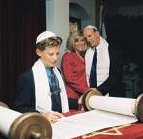|
Basics about Bar Mitzvah
Bar Mitzvah means "son of the commandment" (bar is "son" in Aramaic), and Bat Mitzvah means "daughter of the commandment" (bat means "daughter" in both Hebrew and Aramaic). A Jewish boy automatically becomes a bar mitzvah upon reaching the age of 13, and a girl upon reaching the age of 12, and no ceremony is required according to Jewish halakhah (law). This is referred to as the "commandment age", the "age of majority", or a "religious coming of age," and implies that all of the responsibilities and religious obligations of the Torah and Rabbis are now binding on the child.
Though there is no formal requirement to perform a bar/bat mitzvah ritual, it is customary to observe Bar/Bat Mitzvah ceremonies as "rites of passage" that symbolize the crossover from childhood to adulthood and to indicate that the child is now subject to the privileges and obligations of fulfilling the commandments as prescribed in the Torah of Moses (and as normally interpreted by the Jewish sages and Rabbis in terms of "Oral Law").
Note that according to Jewish rabbinical thinking, bar mitzvah boys are obligated to fulfill all positive and negative commandments of the Torah (an example of a negative commandment would be the prohibition against eating pork, whereas an example of a positive commandment would be the requirement to put on tefillin every day). Bat Mitzvah girls are obligated to observe all prohibitions of the Torah and to fulfill all positive commandments which do not have time dependencies. Therefore, Jewish women would be prohibited from eating pork but would not be required to observe the mitzvah of tefillin (since the commandment of tefillin has time restrictions when it may be fulfilled).
The exemption from observing mitzvot which are time dependent means that women are not under obligation to wear fringes (tzitzit), since this is done only during the daylight hours. Nor are they required to wear a Tallit, since this is worn only during morning services at the synagogue or during Torah readings during the morning service. Nor are women required to put on tefillin, since these are likewise worn during morning prayers in the synagogue.
Generally speaking, a bar mitzvah marks the child's first aliyah. Minimally, during a Shabbat service shortly after the child's 13th birthday, the child is called up to the Torah to recite a blessing over the weekly reading. Additional Bar Mitzvah customs include:
- Reciting the traditional Hebrew blessing over the Torah
- Reading the entire weekly torah portion in Hebrew (this is based on the portion determined for the child's Hebrew birth date)
- Chanting the entire haftarah portion
- Making a short drash (speech) regarding the Torah or Haftarah portion (which traditionally begins with the phrase "today I am a man")
After the readings and sermon, the child's father often recites a blessing thanking God for removing the burden of being responsible for the son's sins (because now the child is old enough to be held responsible for himself).
The ritual service is then followed by an oneg (reception) that is often as elaborate as a wedding reception, with special music, foods, gifts, and so on. This celebration is considered an important component of the life cycle, since it honors the child's (and parents) accomplishments and gives loved ones and others the opportunity to show naches (great pride) and joy for the child.
Preparing for a Bar/Bat Mitzvah is a major undertaking for any family, and the planning process starts at least two years in advance. There is so much to do: picking the exact date; determining the correct Torah/Haftarah readings (and getting the child prepared to read them before the congregation), renting a hall for the oneg; hiring a caterer, photographer, entertainer, etc.; making up the guest list, and so on. In addition, many congregations include the tradition that each Bar/Bat Mitzvah family makes up it's own siddur (prayer book) for the ceremony. This will require that you find the appropriate prayers in Hebrew, type in the English text, inserting Jewish graphics, and get these produced for the special occasion at the synagogue.
B'nai Mitvah Gifts
As with weddings and other life events, it is common to give the Bar or Bat Mitzvah celebrant a gift to commemorate the occasion. Common gifts include books with religious or educational value, religious items, writing implements, savings bonds or gift certificates. Because the Hebrew word for "life" ("chai") is also the Hebrew number 18, monetary gifts in multiples of 18 dollars (i.e. $36, $180, etc.) are considered to be appropriate. Many B'nai Mitzvah also receive their first tallit from their parents to be used for the occasion.
A Second Bar Mitzvah
Among religious Jews, it is customary for a man who is lucky enough to reach the age of 83 to celebrate a second bar mitzvah, using the reasoning that a "normal" life span is 70 years, so an 83-year-old can be considered 13 in a second lifetime!
|

